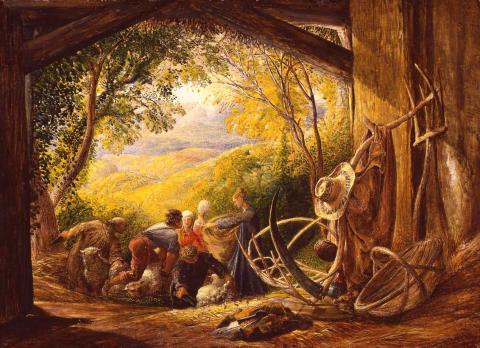
Oxford and Canterbury join forces to save a masterpiece of English Romantic painting for the nation
Oxford and Canterbury join forces to save a masterpiece of English Romantic painting for the nation.

The Ashmolean Museum, Oxford, and Canterbury Museums Services, Kent, are together trying to raise £3.8million to prevent one of the acknowledged masterpieces by Samuel Palmer from going abroad. They have already had promises of extraordinary support in the form of a £1.5million grant from the National Heritage Memorial Fund (NHMF), and £500,000 from The Art Fund should the remaining funds be found to meet the purchase price – a significant sum to raise.
The painting is currently subject to the temporary deferral of an export licence, which expires on 22 July 2010. Following the advice of the Reviewing Committee on the Export of Works of Art, which gave The Shearers a highly unusual ‘starred’ rating, the Culture Minister, has said that ‘every possible effort’ should be made to keep it in this country.
Samuel Palmer (1805-1881) is one of the best loved of all English artists. The paintings and drawings he created during the years he lived in the village of Shoreham in Kent (1827-1835) are among the most intensely felt and brilliantly imaginative of all English landscapes, and inspired a whole generation of artists from Graham Sutherland to the Neo-Romantics and beyond. Both Sutherland and Kenneth Clark described him as ‘the English Van Gogh’. Inspired by the self-contained, timeless world of the Darent valley, his wide reading of literature from Virgil to Milton, his admiration for William Blake, his study of early ‘primitive’ art, and a strong religious faith, he constructed a ‘visionary’ style of landscape that was personal, intuitive, and completely original.
The Shearers is the most ambitious work of the ‘Shoreham period’, in its scale, complexity, and colouring. It shows the interior of the old Shepherd’s Barn at Shoreham (dismantled in the 1980s to make way for the M25), looking out onto a lush, golden valley in the Kentish countryside. In front of the barn, a group of shearers are at work, at various stages of progress in their task. Inside the barn is a still life of farm implements – scythe, thresher, basket, and fork – together with the large patterned straw hat that Palmer wore while living in Shoreham, and which he later cherished as the symbol of the happiest period of his life.
The dominant role of the agricultural labourers at work is most unusual in English art before 1850, and unique in Palmer’s output. He may have been reacting to recent political developments such as the Great Reform Act of 1832, which ended the close relationship between the Church of England and the countryside. For, like his mentor, William Blake, Palmer believed in the possibility of a heavenly Jerusalem in England. In this sense, The Shearers offers a timeless and harmonious vision of England, free of ‘dark, satanic mills’, in which labour is rewarded with the promise of a place in paradise.
Canterbury Museums and Galleries are the nearest public collection to Shoreham, where the picture was painted. There are currently no works by Palmer in public collections in Kent. The Ashmolean Museum houses the most representative collection of Palmer’s works in the world, from the haunting sepia drawings of 1825 to the magisterial Prospect, which he completed on his deathbed. If the campaign to purchase The Shearers is successful, it will be shared between Canterbury and Oxford for future generations to enjoy.
Further information
Natasha Ley or Alison Scott, NHMF Press Officers,
Phone: (020) 7591 6102/6032 Mobile: 07973 613820.

